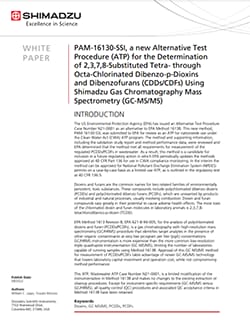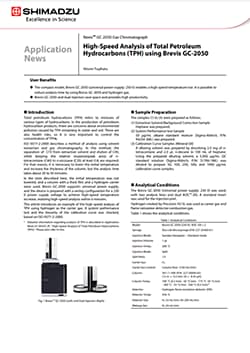Industrial Waste and Others
Diverse contaminants (pesticides, PCBs, dioxins, furans, PAHs, TPHs, metals…) are present in industrial waste, soils and other solid matrices. Shimadzu offers an array of solutions vetted for the analysis of these contaminants in these challenging samples, following EPA methods (e.g. EPA 8260, EPA 8270), ASTM methods and more.
Applications
PAM-16130-SSI, a new Alternative Test Procedure (ATP) for the Determination of 2,3,7,8-Substituted Tetra- through Octa-Chlorinated Dibenzo-p-Dioxins and Dibenzofurans (CDDs/CDFs) Using Shimadzu Gas Chromatography Mass Spectrometry (GC-MS/MS)
The US Environmental Protection Agency (EPA) has issued an Alternative Test Procedure Case Number N21-0001 as an alternative to EPA Method 1613B. This new method, PAM-16130-SSI, was submitted to EPA for review as an ATP for nationwide use under the Clean Water Act (CWA) ATP program. The method and supporting information, including the validation study report and method performance data, were reviewed and EPA determined that the method met all requirements for measurement of the regulated PCDDs/PCDFs in wastewater. As a result, this method is a candidate for inclusion in a future regulatory action in which EPA periodically updates the methods approved at 40 CFR Part 136 for use in CWA compliance monitoring. In the interim the method can be approved for National Pollutant Discharge Elimination System (NPDES) permits on a case-by-case basis as a limited-use ATP, as is outlined in the regulatory text at 40 CFR 136.5.
More information about the Alternative Test Procedure to EPA Method 1613B can be found here
High-Speed Analysis of Total Petroleum Hydrocarbons (TPH) using Brevis GC-2050
Total petroleum hydrocarbons (TPH) refers to mixtures of various types of hydrocarbons. In the production of petroleum hydrocarbon products, there are concerns about environmental pollution caused by TPH remaining in water and soil. There are also health risks, so it is very important to control the concentration of TPHs. ISO 9377-2-2000 describes a method of analysis using solvent extraction and gas chromatography. In this method, the separation of C10 from extraction solvent and elution of C40, while keeping the relative response(peak area) of ntetracontane (C40) to n-eicosane (C20) at least 0.8, are required. For that reason, it is necessary to lower the initial temperature and increase the thickness of the column, but the analysis time takes about 20 to 30 minutes. In the tests described here, the initial temperature was not lowered, and a column with a thick film and a hydrogen carrier were used. Brevis GC-2050 supports universal power supply, and the device is prepared with a wiring configuration for a 230 V power supply voltage to achieve high-speed temperature increase, realizing high-speed analysis within 6 minutes. This article introduces an example of the high-speed analysis of TPH using hydrogen as the carrier gas. A system performance test and the linearity of the calibration curve was checked, based on ISO 9377-2-2000.





